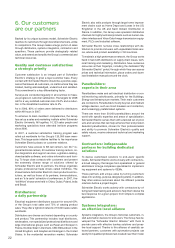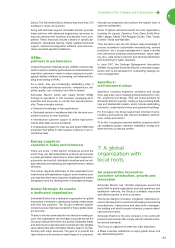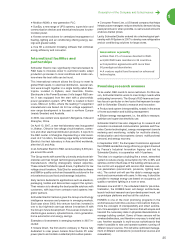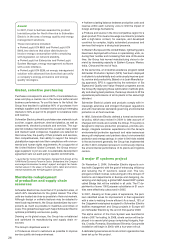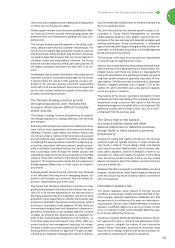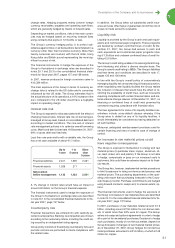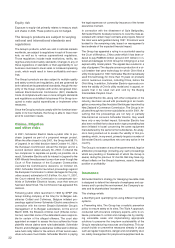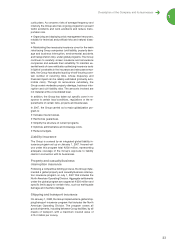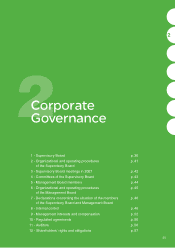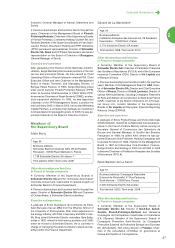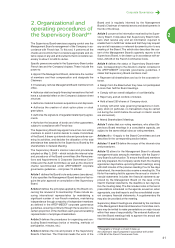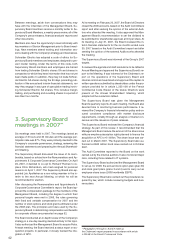APC 2007 Annual Report Download - page 34
Download and view the complete annual report
Please find page 34 of the 2007 APC annual report below. You can navigate through the pages in the report by either clicking on the pages listed below, or by using the keyword search tool below to find specific information within the annual report.32
Equity risk
Exposure to equity risk primarily relates to treasury stock
and shares in AXA. These positions are not hedged.
The Group’s products are subject to varying
national and international standards and
regulations
The Group’s products, which are sold in national markets
worldwide, are subject to regulations in each of those mar-
kets, as well as to various supranational regulations.
Those regulations include trade restrictions, tariffs, tax
regimes and product safety standards. Changes to any of
these regulations or standards or their applicability to our
business could lead to lower sales or increased operating
costs, which would result in lower profitability and earn-
ings.
The Group’s products are also subject to multiple quality
and safety controls and regulations, and are governed by
both national and supranational standards, though the ma-
jority of the lineup complies with world–recognized Inter-
national Electrotechnical Commission (IEC) standards.
Costs of compliance with new or more stringent standards
and regulations could affect its business if the Group is re-
quired to make capital expenditures or implement other
measures.
Since the Group’s products comply with the dominant stan-
dards in its host markets, the Group is able to meet most
all of its customers’ needs.
Claims, litigation
and other risks
In 2001, Schneider Electric made a public offer to pur-
chase Legrand as part of a proposed merger project.
When the offer closed in July 2001, the Group held 98.1%
of Legrand. In an initial decision dated October 10, 2001,
the European Commission vetoed the merger, and in a
second decision dated January 30, 2002, it ordered the
two companies to separate as quickly as possible. As a
result, Schneider Electric sold its interest in Legrand to the
KKR-Wendel Investissement consortium even though the
Court of First Instance of the European Communities
overruled the Commission’s decisions on October 22,
2002. Schneider Electric launched proceedings against
the European Commission to obtain damages for the prej-
udice caused, estimated at 1.6 billion. On July 11, 2007,
the Court ordered the Commission to compensate two-
thirds of Schneider Electric’s losses, once their amount
has been determined. The Commission has appealed this
decision.
Following public offers launched in 1993 by SPEP (the
Group holding company at the time) for its Belgian sub-
sidiaries Cofibel and Cofimines, Belgium initiated pro-
ceedings against former Schneider Electric executives in
connection with the former Empain-Schneider Group's
management of its Belgian subsidiaries. At the end of
March 2006, the Brussels criminal court (tribunal correc-
tionnel) ruled that some of the defendants were responsi-
ble for certain of the alleged offenses. The court also
appointed an expert to assess the loss suffered by those
plaintiffs whose claims were ruled admissible. Schneider
Electric and its Belgian subsidiaries Cofibel and Cofimines
were held civilly liable for the actions of their senior exec-
utives who were found liable. Schneider Electric is paying
the legal expenses not covered by insurance of the former
executives involved.
In connection with the divestment of Spie Batignolles,
Schneider Electric booked provisions to cover the risks as-
sociated with certain major contracts and projects. Most of
the risks were extinguished during 1997. Provisions were
booked for the remaining risks, based on management’s
best estimate of the expected financial impact.
The Group has appealed a ruling in a counterfeit case by
the Court of Wenzhou, China under which it has been or-
dered to pay RMB330 million (around 31 million) in in-
terest and damages to Chint Group for infringing on a now
expired utility model patent. The appeal has resulted in a
stay of judgment. The dispute concerns production of a cir-
cuit breaker that uses technology for which Chint filed a
utility model patent in 1997. Schneider Electric had already
used this technology for more than 15 years on products
sold in numerous countries, including China, before the
Chint filing. In addition, Schneider Electric vigorously con-
tents the validity of Chint’s utility model and, in appeal, re-
quests that it be ruled null and void by the Beijing
Intermediate People’s Court.
Schneider Electric SA, along with other companies in the
industry, has been served with proceedings in an investi-
gation concerning Gas Insulated Switchgear launched by
New Zealand’s Commerce Commission. The Group is im-
plicated through two former subsidiaries sold in 2001. As-
suming that the proceedings are not fully or partially
time-barred as concerns Schneider Electric, they would
have only a very limited impact. Schneider Electric has
also been notified that a class-action type proceeding has
been initiated in Israel concerning the same equipment
manufactured by the same former subsidiaries. An analy-
sis is being carried out to assess the validity of this pro-
ceeding, which, in any event, primarily targets a number of
Schneider Electric competitors who are very active in the
country.
The Group is not aware of any other governmental, legal or
arbitration proceedings (including any such proceedings
which are pending or threatened of which the Group is
aware) during the previous 12 months that may have sig-
nificant effects on the Group’s business, assets, financial
position or profitability
Insurance
Schneider Electric’s strategy for managing insurable risks
is designed to defend the interests of employees and cus-
tomers and to protect the environment, the Company's as-
sets and its shareholders' investment.
This strategy entails:
Identifying and quantifying risk using different reporting
systems.
Preventing risks. The Group has a realistic prevention
policy to ensure safety at its sites. The Triple A approach,
conducted with insurance company experts, aims to en-
hance processes to control and manage risk by identify-
ing vulnerable areas and implementing appropriate
solutions to preserve the long-term sustainability of the
Group’s manufacturing resources and business. This ap-
proach builds on preventive measures already in place
such as regular inspections, danger and vulnerability stud-
ies, safety management for people and equipment and se-


